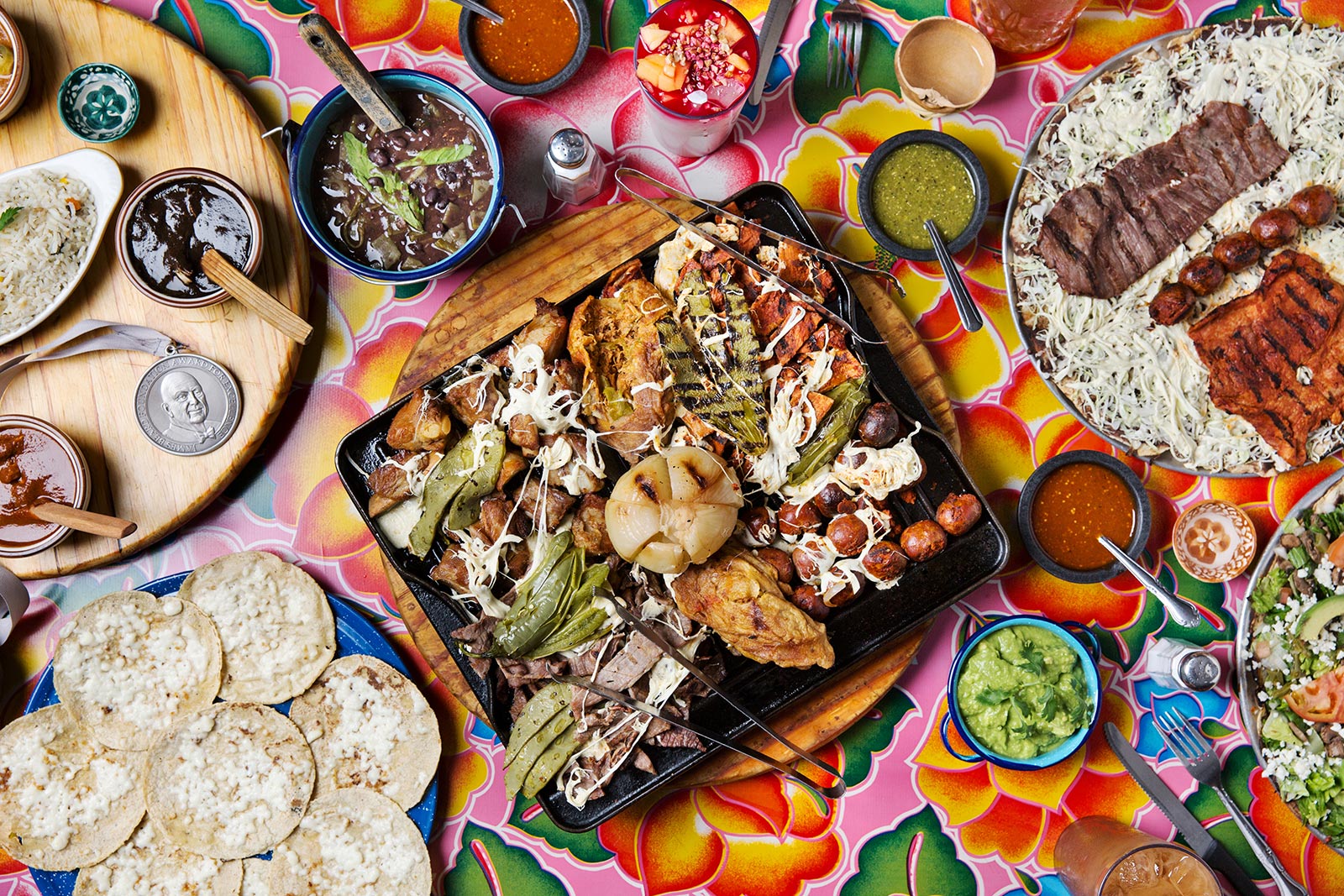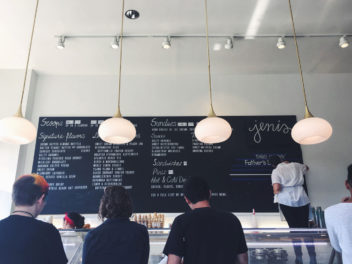
A Mexican feast at Guelaguetza. Co-owned by Bricia Lopez, Guelaguetza is a restaurant, market, and advocate of Oaxacan cuisine in Koreatown. Photo courtesy of Guelaguetza
Together, critic Jonathan Gold, food scholar Evan Kleiman, and chefs Ray Garcia, Bricia Lopez, and Carlos Salgado have spent more than a lifetime preparing, eating, and writing about Latin American cuisine. Before their recent panel discussion at the Getty, offered in conjunction with Pacific Standard Time, they sat down with us to reflect on the role of Mexican cuisine in the life of Los Angeles and how we might expand our taste buds to go deeper.
SS: Pacific Standard Time: LA/LA is about recognizing the formative relationship between Latin American culture and the identity of Los Angeles as a city. From your perspective, where does food fit in?
JG: Food is the easiest way for one culture to comprehend another. Food is a brilliant carrier of culture, because it’s so closely tied to the land that a culture grows up in, the particular geography, the nature, the immigration patterns. When you go into a restaurant, when you’re with people one-on-one and you’re feeding them and nurturing them, or you’re being fed and you’re being nurtured and cared for, I think there’s a real chance for cultural understanding.
BL: Food is the heart and soul of this city, and it welcomes people to acceptance of other people’s cultures. For example, mole: there was a generation of people who didn’t know what mole was until my family came and started selling mole, and now they have a deeper appreciation of the culture because of it. It’s like a catalyst, it’s a connection.
CS: Personally, I think it’s inarguable that Mexican cuisine is essentially the defining cuisine of LA. There are more Mexican restaurants than any other kind in Southern California. Everyone is a little bit Mexican in LA.

In the Getty Center auditorium for the recent “There Will Be Food“ panel. From left, Evan Kleiman, Ray Garcia, Bricia Lopez, Carlos Salgado, and Jonathan Gold
SS: How do you feel the perception of, and value placed on, Latin American cuisine has changed in Los Angeles in your lifetime?
RG: I think the value of Latin American and for me specifically Mexican cuisine has increased tremendously. For most of what I can remember, people were like “it’s Mexican food, so it’s tacos and rice and beans,” and it’s a combination [plate] 1–4, and cheese melted over the top of it. And now, people are excited to push that envelope. You have chefs and restaurateurs who are excited and obliged to drive that conversation, and it takes them a little deeper into an exploration of their own craft.
BL: It’s definitely been an uphill battle. Today I think there is still a large number of people who consider Mexican food as “cheap food.” But I think more and more people are learning how many ingredients go into one thing, and how much work. It’s not just tortillas and whatever meat you find. I think people are becoming more educated, they want to know more about their food, what it is, where it came from, the history behind it.
CS: We all know those stylish, big Mexican restaurants that generally appealed to Americans, and had more of the trappings of the American restaurants. And where was the best Mexican food? In restaurants that are truly, truly Mexican. As with any lower-price restaurant of immigrant cuisine, they tend to not look as nice, and people have a certain perception of that. Undoubtedly there are racist perceptions. Those restaurants still exist, and those perceptions still exist. So that is something that we consciously have to manage. Managing the aesthetics and the language and the lexicon in order to remove some of the barriers that cause people to value that cuisine a little bit less is very important.

Dishes at Broken Spanish, in Downtown LA. Chef Ray draws inspiration and flavors from diverse Latin American cuisines. Photo courtesy of Broken Spanish
SS: As a chef (or critic), do you consider yourself an artist?
EK: Art to me often has an intellectual component. I think of food preparation as a craft–I don’t think of it as art.
RG: My personal approach to food is more of a craftsman. I like having my tools in hand, sort of creating and building, and my approach is much more trial and error. It’s part social scientist, and part repair person or builder. I put food out, and wait for the reaction, and see what we can push, what we can improve.
JG: I’m a writer. Some people can call writers artists, some people cannot. In terms of food, there are people who approach cuisine from an art angle. Carlos Salgado is astonishing that way. His food is rooted in Mexican flavors, but there’s this level of abstraction in his food. Is it art as opposed to food? No, it’s food, but it’s being approached in a different way.
CS: The highest point in my life is being with close family and friends, in the backyard over a fire, cooking over the course of many hours, sitting under the sky, and just filling this space with so much warmth. When I’m cooking there, I feel much more like an artist than when I worked in the highest-concept restaurants. They are like museums of food, accessible only with a certain level of literacy on the part of the diner, with a certain level of cultural experience and background.

Tamale with pepitas at Taco María in Costa Mesa, where chef Carlos Salgado creates Mexican-inspired “Alta California” cuisine. Photo courtesy of Taco María
SS: This panel represents Mexican American cuisine in LA. What other kinds of Latin American cuisine or particular dishes from other regions do you like?
JG: El Salvadoreño cooking. It’s very basic, but the ways they use corn and greens and cheese. The fermentations are lovely.
EK: I love Guatemalan tamales, maybe more than Mexican tamales. The masa is often mixed with potato, so it’s much more tender. They’re wrapped in banana leaves, so there’s a different flavor. And the way they are filled is different; often there’s olives or raisins or prunes in them.
BL: I love Peruvian food. Everything from the ceviche to rice and beans, all of the flavors. It has so much depth.
CS: Baja coastal cuisine. The freshness of it–you eat seafood in the morning because it just came in. Very simply prepared, very intense, briny ocean flavors: big clams, oysters, shrimp. Big, big flavors.
SS: If you could recommend one dish or element in Mexican-American cuisine that a total beginner must try, what would it be?
EK: Tacos, because anything you eat with your hands is less intimidating than something that requires silverware. It takes you back to the permission of childhood, and that joy of just eating that is super direct. There is nothing in between you and the food.
BL: I think mole is a really good one. A lot of people think of it as a chocolate sauce, and yes, it has chocolate, but it also has like 18 other things. I always recommend three things: mole, the barbacoa, and the chiles rellenos at my restaurant, just because I think they are universally delicious.
CS: I would say try more and different types of chilies, and the salsas that result from them. The range of flavors, and balance of flavors, is really exciting, and is my favorite part of Mexican food.
RG: Put aside your thoughts and limitations on what Mexican food can be, and how much it can cost. Especially in LA, there is almost a cult-like following for cheap Mexican food, for the greasy taco truck. There is something people find exciting about that, but I think it’s good to stop and wonder why your taco costs a dollar. There must be a lot behind it that allows you to eat a dollar taco. It probably doesn’t include a living wage, a safe work environment, or the best quality ingredients for you and your body. We could understand where our food is coming from and be a bit more conscious in our choices.




Comments on this post are now closed.